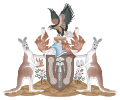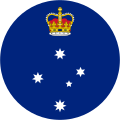 | |
| Heraldic tradition | Gallo-British |
|---|---|
| Governing body | Disputed |
Australian heraldry is the style and tradition of using armorial achievements, sometimes known as coats of arms, and other heraldic bearings and insignia in Australia. It largely follows the Gallo-British tradition of heraldry also followed in England, Scotland, Ireland, Canada and New Zealand.





































